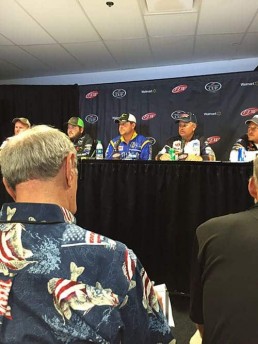The Tin Man Rules the FLW Forrest Wood Cup
SHARE THIS POST
Fifty of the top bass fishermen competed for $300,000 and the FLW Forrest Wood Cup trophy on Alabama’s Lake Wheeler in early August.
No one has ever won this contest more than once.
This was one of the best venues for a major bass tournament that we’ve ever attended. Host city Huntsville, Ala., is beautiful, historic and modern southern town with a railroad depot stop, brick homes dating to the early 1800s, a Space Museum, colleges and fine restaurants and businesses. The marina for the event was only 15 minutes from the host hotel, while the weigh-in arena was in a delightful park setting with connecting ponds and canals containing hundreds of the some of the largest Koi fish ever seen.
Former FLW Cup-winner, Jacob Wheeler, speculated that tough summer conditions would result in a 13 1/2-pound average per fish over the four-day event, so it was believed, by him and by others, that a 54-pound total would win. Others estimated it would take up to 64 pounds to notch the victory.
John Cox, one of the competitors, seemed to be very hopeful and confident.
As an observer, I felt that Wheeler or Cox would win.
The thing that makes our favorite sport so interesting is that it’s such a puzzle: Where are the bass located? Which lures will work? What techniques will it take to catch them?
This is one of the reasons we love tournaments. Some can claim certain lures and tools are the greatest, but as we have learned in racing, “The baloney stops when the flag drops!”
FLW’s online coverage now gives us insight through reports and coverage to see and to compare how contestants are doing and the techniques with which we might use in similar conditions. The interviews with anglers each day also allows reporters to glean finer details to share with fans and anglers.
After the first day, it became evident that patterns were prevalent. First the deep-ledge bite projected by many Tennessee River impoundment specialists to harbor the big ones failed to produce. Many specialized on schooling bass near gravel points and could catch up to 40 bass per day. To do this, it was necessary to keep rods at the ready to land their lures within an inch and in a second of any surfacing to have a chance. The problem with these fish was that so much energy was expended competing with other bass and bait and that their heads were big and bodies skinny, lacking desired competition weights.
The other productive pattern was fishing shallow cover, which produced fewer but fatter bass. John Cox took this to an extreme, having the proper tool that allowed him to fish a shallow tributary that most bass boats couldn’t access.
Are you enjoying this post?
You can be among the first to get the latest info on where to go, what to use and how to use it!
But more on Lake Wheeler than with most tournaments, fishing the same baits in the same areas and specific covers resulted in varying results.
Jacob Wheeler’s totaled 8 pounds, 5 ounces on Day One, placing him 32nd. He followed that with 17 pounds, 9 ounces on Day Two though, jumping up to second place. Similarly, Todd Auten had 17 pounds, 10 ounces on Day Three, moving him to second place then slipping to third on Day Four when he garnered only 7 pounds, 9 ounces.
John Cox’s Crestliner aluminum boat went farther back into the coves and feeder rivers than the other competitors. Earlier this year, Cox took it through a culvert to win a FLW contest. A rainstorm the day before the FLW Cup carried duckweed to a tributary he was fishing in. That forced John to search through his tackle to find three Jackall Iobee Topwater Frog lures he hadn’t fished with for five years. The built-in keel on this floating frog bait allows an angler to walk the dog on a retrieve, triggering strikes. (I tried one on my pond and produced a strike from a bass on the first cast.)
Though most anglers miss so many fish that strike the surface frogs, Cox said he only missed two the entire four days of the event. He believes he caught the same hard-striking bass he had missed twice on Day Four and that it was the biggest one in his final bag, which eventually sealed his huge win at 54 pounds, 13 ounces.
Cox had nearly matched Jacob Wheeler’s prediction.
The veteran had also won using his own constructed rod with Mud Hole products.
Some of the contestants call John the “Tin Man,” as he fishes in a smaller, aluminum Crestliner boat. So this win was not just for Cox, but also for regular anglers with smaller boats and homemade equipment.
We can get into places others can’t.
Dan Basore is a fishing historian and steward of the history of the sport. In his efforts to preserve fishing history, Basore is always on the lookout for information about early lure makers, old lures, pre- level wind reels, manufacturer catalogs, tournament casting items and the like. If you possess information or materials that can help, please contact Dan Basore, Historical Fishing Display, at 630-393-3474 or 800-347-4525.
MWO
SHARE THIS POST
Did you enjoy this post?
You can be among the first to get the latest info on where to go, what to use and how to use it!
Dan Basore
Dan Basore is a fishing historian and steward of the history of the sport. In his efforts to preserve fishing history, he is always on the lookout for information about early lure makers, old lures, pre-level wind reels, manufacturer catalogs, tournament casting items and the like. If you possess information or materials of this kind, please contact him at 630-393-3474 or by email at ollures@aol.com.




